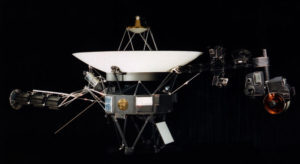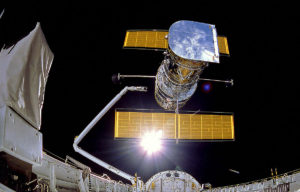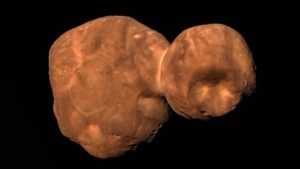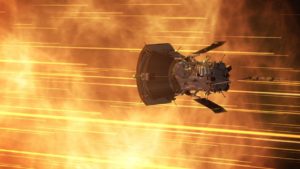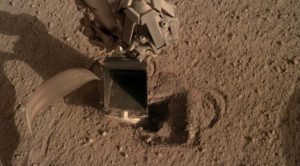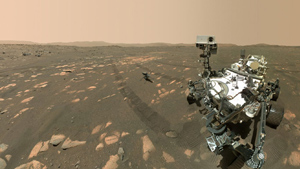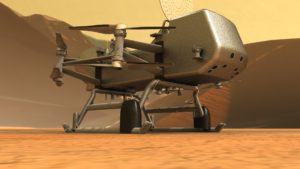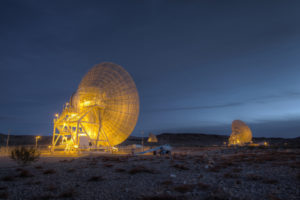Science Missions
There are over 80 science missions operating in space, with more in development. We have included a few of the current and planned NASA missions.
In addition to the focus below on deep space, NASA conducts important missions monitoring the systems and health of our home planet Earth. Further information on NASA’s science missions may be found here.
Current Missions
Current Mission: Voyager 1 & 2 (August and September, 1977)
The twin spacecraft Voyager 1 and 2 have been exploring space for over 40 years, and have gone farther than any other mission. Initially meant to conduct studies of Jupiter and Saturn, Saturn’s rings, and the larger moons of these two planets, they are both now in interstellar space. The Voyager spacecraft are the first human-made objects ever to leave our solar system and the region immediately beyond it. Despite the enormous distances involved – Voyager 2 is over 11 billion miles away and Voyager 1 is over 9 billion miles out– the spacecraft are still sending scientific information about their explorations back to Earth. In addition, the Voyagers each carry a golden record containing pictures and sounds of Earth, directions for playing the record, and data pointing the location of Earth. The record is a time capsule and a message to any civilization that may recover either of the spacecraft.
The Voyagers were built to last five years and to end their observations at Saturn. But as the mission went on, flybys of Uranus and Neptune proved possible by taking advantage of a rare geometric arrangement of the outer planets in the 1970s and 80s, which occurs every 175 years. This “gravity assist” technique allowed the spacecraft to swing from one planet to the next without the need for large onboard propulsion systems. The technique has been used on many missions since being pioneered by the Voyagers. The Voyager spacecraft were also the first ones to be extensively protected against radiation, which set the standard for radiation design margin. They were also the first with programmable computer-controlled attitude, and the first to use the Reed-Solomon code, an algorithm that reduces errors in data transmission and storage.
Some of the Voyager mission discoveries include the Jupiter’s Great Red Spot, a complex storm moving in a counterclockwise direction; the eruption of nine volcanoes on Jupiter’s moon Io (it was the first time that active volcanoes had been seen on a body in the solar system other than Earth); the discovery of Jovian moons Thebe and Metis; and the discovery of Saturn moons Prometheus, Pandora, and Atlas.
The spacecraft were launched in August and September, 1977. Both spacecraft were delivered to space aboard Titan-Centaur rockets.
Current Mission: Hubble (April, 1990)
Located in low Earth orbit at an altitude of 340 miles, Hubble is the first major optical telescope to be placed in space. The telescope observes visible and near-infrared light. By being located in space, the telescope is also able to detect ultraviolet light, which is otherwise absorbed by Earth’s atmosphere. After more than a million observations and 30 years in orbit, the observatory remains productive.
Hubble is equipped with sensitive cameras and spectrographs that can view small and nearby objects and distant star-forming galaxies that date back to millions of years ago. Hubble’s accomplishments include helping to produce a map showing the distribution of dark matter in the universe; obtaining evidence of plumes emanating from Europa that combined with images from other telescopes like Voyager made the case for the presence of water on that world; and producing images that revealed galaxies so distant that they show the universe as it was when it first formed. Hubble also revealed the age of the universe to be about 13.8 billion years, more accurate than the old range of “between 10 and 20 billion years”.
Hubble has also probed the atmosphere of exo-planets, such as several Earth-sized worlds orbiting around the red dwarf star TRAPPIST-1. Using the Hubble Telescope, astronomers have surveyed four of the planets that lie in the star’s habitable zone, a region at a distance from the star where liquid water could exist on the planets’ surfaces. Scientists plan to use the James Webb Space Telescope to probe deeper into the atmospheres.
Lockheed Missiles and Space Company (now Lockheed Martin) built the Hubble spacecraft. The space-based observatory was launched aboard a Space Shuttle Discovery in April 24, 1990.
Current Mission: New Horizons (January, 2006)
New Horizons is a mission to study the dwarf planet Pluto, its moons and other objects in the Kuiper Belt, launched in 2006. By launching that year, New Horizons took advantage of a gravity assist from Jupiter that took the spacecraft to Pluto by 2015.
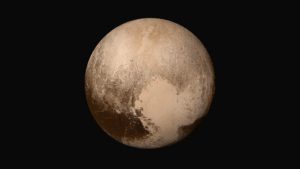
Pluto’s “heart” in an image from the Long Range Reconnaissance Imager (LORRI) aboard New Horizons, taken on July 13, 2015. Credit: NASA/APL/SwRI.
On July 14 2015, the New Horizons spacecraft made its historic flyby of Pluto, providing close-up images of the dwarf planet. From New Horizon’s observations, among other discoveries scientists learned that Pluto has a heart-shaped glacier that is the size of Oklahoma and Texas, that it has a blue atmosphere, mountains as high as the Rockies, and that it is colored red by ammonia. Data from the New Horizons flyby of Pluto helped scientists to conclude on presumptions about the size of Pluto. They found that the dwarf planet is about 1,470 miles in diameter, somewhat larger than believed.
The spacecraft also came close to Pluto’s moon Charon, informing the mission’s science team about its surface composition and location, and revealing a big equatorial extension tectonic belt, which suggests a long-past water-ice ocean. New Horizon’s also revealed the existence of Pluto moons Kerberos and Styx.
After its encounter with Pluto, in 2019 the New Horizons spacecraft flew by an object in the Kuiper Belt called Arrokoth (previously called Ultima Thule). The object is untouched by the usual impacts of most small objects, and, being 4 billion years old as revealed by its craters, the object could tell the story of the earliest years of the solar system’s formation. Arrokoth consists of two parts connected by a neck, and a full orbit around the solar system takes it 298 years. The object’s surface is all red, which could be an indicator of the presence of tholins, a chemical compound seen in many other outer solar system objects, like Titan.
New Horizons is part of NASA’s New Frontiers program, a series of missions that also includes Juno, OSIRIS-REx and future mission Dragonfly. The spacecraft was mainly built by Southwest Research Institue (SwRI) and the Johns Hopkins Applied Physics Laboratory. It was sent into space by an Atlas V rocket through a launch managed by International Launch Services.
Current Mission: JUNO (August 2011)
One of the benefits of exploring deep space is understanding the very beginnings of the solar system, which can ultimately help us to understand where we came from. Formed before other worlds, giant planets such as Jupiter are believed to represent the foundation of planet configuration and orbit-shaping. Studying Jupiter can clarify theories about how heavy elements like carbon and nitrogen moved about in the early universe, offering answers about how rocky planets such as Earth formed.

“Cotton Candy Jupiter”. Image of Jupiter captured by JunoCam and colorized using Photoshop. Credit: NASA/JPL-Caltech/SwRI/ MSSS/ Gerald Eichstädt/ Seán Doran/ Rachel Tortorici.
Juno’s goal is to reveal the story of Jupiter’s formation and evolution. With a spinning spacecraft placed in a highly elliptical polar orbit to avoid Jupiter’s high radiation regions, Juno is currently observing Jupiter’s gravity and magnetic fields, atmospheric dynamics, and composition.
The spacecraft is also equipped with the JunoCam, which takes pictures of Jupiter that are posted to the Mission Juno website for the public to download and process. Juno entered Jupiter’s orbit in 2016. Since then, it has captured stunning and revealing images of Jupiter, in addition to collecting a great deal of data about the gas giant.
CDSE member Lockheed Martin built and operates the Juno spacecraft. One of the unique qualities of the spacecraft is that it is able to generate solar power from Jupiter’s neighborhood, which has been made possible from improved solar-cell performance and energy-efficient instruments. CDSE member’s United Launch Alliance (ULA) Atlas V rocket launched Juno into space in 2011.
Current Mission: OSIRIS-Rex (September 2016)
OSIRIS-REx (Origins, Spectral Interpretation, Resource Identification, Security, Regolith Explorer) is a sample return mission that studies Bennu, an ancient asteroid over 4.5 billion years old. One of its main goals is to help us understand the origin of the solar system and the composition of asteroids. Studying samples from Bennu will help verify and refine telescopic observations, and fill gaps in existing theoretical predictions about asteroids in the solar system. The team leading OSIRIS-REx selected a site called “Nightingale” on Bennu for asteroid sample return. Located in a crater high in Bennu’s northern hemisphere, the site allows for access to the asteroid’s material while keeping the spacecraft safe.

Global map of asteroid Bennu’s surface– a mosaic of images collected by NASA’s OSIRIS-REx spacecraft Mar. 7 – Apr. 19, 2019. Credit:NASA/Goddard/University of Arizona.
In October 2021, the spacecraft tagged with Bennu and collected over two ounces of material from the asteroid. OSIRIS-REx is set to deliver the materials in September 2023. The samples are planned to land in the Utah desert. After returning the samples, the spacecraft will go on to complete an extended mission consisting of traveling to the near-Earth asteroid 99942 Apophis, which will come within 20,000 miles (32,000 kilometers) of Earth in 2029. Re-named OSIRIS- APEX (APophis Explorer), the spacecraft will not collect a sample. However, it will study the asteroid for 18 months and make a maneuver like the one it made while collecting samples at Bennu. The maneuver is intended to expose the Apophis’ subsurface to allow for better analysis of the asteroid.
CDSE member Lockheed Martin built the spacecraft and is providing flight operations for the mission. The mission launched aboard a ULA Atlas V rocket in September 2016.
Current Mission: Parker Solar Probe (August, 2018)
Though the sun is Earth’s source of light and heat, the solar wind, a collection of charged particles that stream from the star can affect our planet’s magnetic field and trigger space weather. Space weather can affect satellites by changing their orbits or interfering with their electronics. In severe cases, it can also disrupt the earth’s magnetic field and damage electrical systems on Earth.
In 1859, a massive solar storm occurred which induced electrical currents that stopped the telegraph for up to two days and caused auroras to be seen from places as far as Cuba and Hawaii. The storm was called the “Carrington event” after astronomer Richard Carrington, whose astronomical observations demonstrated the existence of solar flares and its influence upon the Earth. In 1972, a solar flare knocked out long-distance calls across Illinois, and caused AT&T to redesign its power system for transatlantic cables. This was a notable event at NASA because it occurred in between two Apollo missions. Had it happened during a mission, astronauts on the Moon would have received a large dose of radiation. In 1989, another solar flare caused a blackout in Canada, melted power transformers in New Jersey, and made some satellites tumble out of control for several hours. In 2000, another solar flare caused some satellites to short-circuit and led to radio blackouts. Other major storms occurred in 2003 and 2006.
Because of our world’s dependence on technology, a powerful solar storm today could lead to large social and economic disruptions. A storm the scale of the Carrington event would cause interruptions to communication and navigation systems. Transformers, which are vital in an electrical grid, can be affected, resulting in blackouts and causing cell towers to stop working because of lack of electricity.
The Parker Solar Probe aims to learn more about the sun and the solar wind, and discover how the Sun gives off energy. Without a mission like the Parker Solar Probe, scientists must examine the solar wind from Earth. This is not as effective because the wind is processed by the time it reaches our planet. With a spacecraft coming so close to the Sun (about seven times closer than any spacecraft has come before), scientists will be able to more accurately predict space weather effects that can cause issues on Earth and on space assets.
The Parker Solar Probe is named after living physicist Eugene Parker, who first proposed the theory of the solar wind and described the entire system of plasma, magnetic fields, and energetic particles that make up the phenomenon. Doubted at first, his theory about the solar wind was proved in 1962 with data from the Mariner 2 mission to Venus. Now, the Parker Solar Probe is poised to provide the best-ever data to answer many of the questions raised by Dr. Parker.
The Probe launched in August 2018 on a United Launch Alliance Delta IV-Heavy. After completing two solar encounters, Parker Solar transmitted 22 gigabytes of science data, 50% over the amount the team had estimated would be downlinked by this point. The Parker Solar Probe team released the scientific data collected during the Probe’s first two solar flybys in the form of files and graphics. The data is available for the public to analyze and plot.
Current Mission: Mars Interior Exploration using Seismic Investigations, Geodesy and Heat Transport (InSight) Lander (May, 2018)
InSight is the first robotic explorer to thoroughly study Mars’ crust, mantle, and core. Studying Mars’ interior is important because the planet preserves the record of its formation, which can help scientists discover how Earth-like planets are formed. Studying Mars’ interior can also offer clues on how active Mars actually is.
The rover is equipped with a Seismic Experiment for Interior Structure (SEIS) instrument, provided by the French space agency CNES, to detect quakes on Mars. Mars does not have tectonic plates: its quakes come from a continual process of cooling and contraction that creates stress which builds over time until the crust breaks. On April 6, 2019 (128th Martian day, or sol), InSight detected the first trembling that seems to have come from inside the planet; data from the event is being analyzed.
InSight is also equipped with a heat probe provided by the German Aerospace Center (DLR), known as the mole. The mole is a tube with a sharp end and an internal hammer that pounds the instrument into the ground. Its purpose is to dig 10 to 16 feet beneath the planet’s dirt to understand soil characteristics, which would be critical to future activities such as habitation. When the digging of Martian soil started in February 2019, the mole started presenting issues, getting stuck after a few inches.
The mole’s struggle to penetrate the soil on Mars is attributed to the small size of the Martian sand and the way dirt behaves on the Red Planet as a result of low atmospheric pressure. The mole’s struggle has taught us that the soil on Mars is dusty and cohesive at the same time. Unlike holes dug on Earth, the one excavated on Mars by InSight has no lip of dirt around its rim because the soil is pounded back into the ground. This means that the Martian soil is unlike anything seen on Earth, making the Martian soil very “extraterrestrial”.
In the first mission of its kind, two SmallSats, called Mars Cube One, or MarCO, were launched in the same flight as InSight to test miniaturized deep space communication equipment. Equipped with radio that provides both UHF (receive) and X-band (receive and transmit) functions, the MarCOs communicated InSight landing information in near-real-time. The CubeSats, which ceased operations in early 2020, were demonstration of potential future capability. The MarCO were propelled by CDSE member VACCO’s smart Micro Propulsion System (MiPS).
The InSight mission team has decided to end the mission by the end of 2022.
The InSight lander was manufactured by Lockheed Martin. It was launched to Mars on a ULA Atlas V rocket in May 2018.
Current Mission: Mars Perseverance Rover (July, 2020)
The Perseverance rover landed in Mars’ Jezero Crater, an ancient lake likely to have hosted microbial life, in February 2021. The mission’s overall objectives are to study Mars’ habitability, seek signs of past life, collect samples, and prepare for human missions to the Red Planet.
To achieve its goals, the Perseverance rover will be the first robot on Mars to fetch samples from Martian rocks and soil, which will be kept on the planet for a potential future mission to return to Earth for analysis. The rover is equipped for learning more about Mars’ climate and environment, helping identify challenges for future crewed missions to the Red Planet. The rover will have technology for extracting oxygen from the Martian atmosphere, which, along with other mission demonstrations, will help plan out ways of using Mars’ natural resources to support human missions to the Red Planet.
In a first-ever technology development, the rover brought along a helicopter attached to its belly, called “Ingenuity,” to prove the viability and potential of heavier-than-air vehicles on Mars. Helicopters may be used in the future as low-flying scouts to access locations not reachable by ground travel.
The Perseverance rover launched in the summer of 2020 on a United Launch Alliance Atlas V rocket and landed on the Red Planet in February 2021.
Current Mission: James Webb Space Telescope (JWST) (December 2021)
James Webb is a space-based telescope, and the latest in a series of “Grand Observatories” that are expanding our knowledge of astronomy and astrophysics. It will continue Hubble’s legacy.
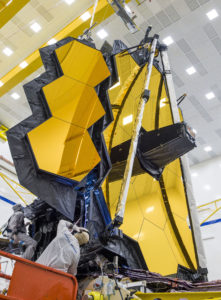
Deployment tests like these help safeguard mission success by physically demonstrating that NASA’s James Webb Space Telescope is able to move and unfold as intended. Credits: NASA/Chris Gunn.
Equipped with a large segmented mirror that can look at high frequencies of light, and located almost one million miles away from Earth, it will study galaxy, star, and planet formation. Webb will view the universe at infrared wavelengths, which will allow it to look further back in time to see the first galaxies that formed in the early universe and help scientists learn more about black holes. It is only with infrared wavelengths that the first stars and galaxies forming early on can be seen. The Webb will also be able to see inside dust clouds where stars and planets are being born nearby, and study exoplanet atmospheres.
Several new technologies ranging from optics to detectors to thermal control systems have been developed so the James Webb Telescope can carry out its mission of transforming our understanding of astrophysics and the origin of galaxies and planetary systems.
For example, the Webb is equipped with a five-layer sunshield to protect its mirrors and instruments from heat that could damage the telescopes highly sophisticated instruments. In addition, the telescope’s microshutters are a new technology developed exclusively for the James Webb, which will help its Near Infrared Spectrograph record the spectra of light from distant objects.
After going through a period of preparations, Webb released its first images in July 2022, including the deepest infrared view of the universe that has ever been taken. Webb also has made new observations of Jupiter, and a direct picture of the exoplanet.
JWST is a collaboration between NASA, the European Space Agency (ESA), and the Canadian Space Agency (CSA). The prime contractor responsible for overall development is Coalition member Northrop Grumman. The mission is planned for 2021.
Future Missions
Future Mission: Psyche (Launch date in review)
Deep inside rocky worlds, scientists presume there are metal cores that are unreachable due to being located underneath rocky mantles and crusts.
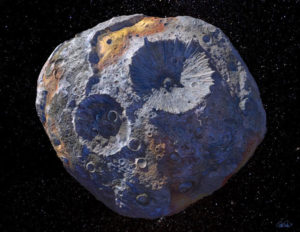
Artist’s concept of the asteroid 16 Psyche, which is thought to be a stripped planetary core. Credit: Maxar/ ASU/ P. Rubin/ NASA/ JPL-Caltech.
The mission is a journey to the 16 Psyche asteroid, a metal world located between Mars and Jupiter that is presumed to be a stripped planetary core. The mission will seek to know how old the asteroid is, what its surface is like, and whether it formed in similar ways to Earth’s core. Psyche will also offer an opportunity to learn about the history of collisions that created terrestrial planets.
CDSE member Maxar is developing the mission spacecraft’s solar electric propulsion system, as well as its main on-board computer, the Psyche Computer Element. For the first time, the Psyche spacecraft will test a new laser communication technology called the Deep Space Optical Communication, which will encode data in photons to communicate with Earth.
Future Mission: Europa Clipper (Planned for 2024)
Searching for life on other worlds will help us understand life evolution, and confirm or deny the universality of the laws of physics and biology. Missions like the Europa Clipper can find out what biological planetary and cosmic conditions must exist for life to develop, and whether all life in the cosmos follows the same evolutionary steps in the same order.
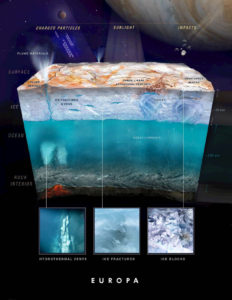
Artistic representation of Europa in cross-section showing processes from the seafloor to the surface. Credit: K.P. Hand et al. / NASA.
Europa is suspected to have the “building blocks of life,” making it attractive for exploration. There is evidence of an ocean on Europa. Water is a fundamental ingredient for life that dissolves nutrients for organisms to eat, and transports chemicals within living cells. Scientists also believe Europa has energy. Its energy would come from Jupiter’s radiation and not from the Sun, meaning life there would not be powered by photosynthesis but by chemical reactions. Under these conditions, life would not survive on the surface, but it could exist in an ocean below it. The other ingredient Europa is suspected to have is chemistry. Life as we know it needs elements like carbon, hydrogen, nitrogen, oxygen, phosphorus, and sulfur to thrive.
The Europa Clipper will include cameras and spectrometers to produce high-resolution images and maps of the moon’s surface and atmosphere; an ice-penetrating radar to search for subsurface water; and a magnetometer and gravity measurements to measure the moon’s magnetic field and reveal clues about its ocean. The Clipper will also carry a thermal instrument to identify locations of warmer ice.
NASA’s Jet Propulsion Laboratory is building the Europa Clipper. In August 2019, the mission was confirmed to move on to final design and testing of the entire spacecraft and science payload.
Future Mission: Dragonfly (Planned for 2027)
Dragonfly is a multi-rotor vehicle that will fly like a drone on Saturn’s moon Titan to sample and study many locations on that world. Titan is believed to be an analog to the very early Earth, which means it can potentially provide clues to how life may have formed on our planet. Titan has a nitrogen-based atmosphere like Earth, and its weather and surface have organics, energy, and water, similar to those that may have started life on our planet.
The mission’s baseline is 2.7 years, during which the aircraft will study craters where liquid water and organic materials key to life might have existed. Dragonfly will also study the moon’s subsurface ocean and liquid reservoirs.
The two Voyager spacecraft first observed Titan in 1979 and 1980, but the images were not very clear. The Hubble Space Telescope captured a better image in 1994, and in 2004 Cassini observed Titan’s surface and discovered the moon’s salty ocean beneath its water-ice crust.
Dragonfly is part of NASA’s New Frontiers program, which supports missions that have been identified as top solar system exploration priorities. The program includes New Horizons, Juno, and OSIRIS-REx, described above.
Led by the Johns Hopkins University’s Applied Physics Laboratory, dragonfly will launch in 2026 and arrive in 2034.
Deep Space Communication Infrastructure: Deep Space Network
The Deep Space Network provides a two-way communications link that guides and controls various NASA and non-NASA interplanetary missions. It consists of 230ft radio antennas aided by smaller dishes, that can pick up signals from millions of miles away in space that are as faint as 20 watts. The antennas are located approximately 120 degrees apart on Earth near Canberra, Australia, near Madrid, Spain, and near Barstow, California to allow for continuous communication with spacecraft. They are available 24 hours a day, every day of the year.
Besides ground communications with spacecraft in deep space, the DSN provides radio astronomy, which allows scientists to study the solar system and examine star evolution in the Milky Way galaxy. The radio frequencies transmitted by the DSN are used to analyze the materials in comets, planetary atmospheres, and clouds of dust in space. Also, because radio waves pass through the dust clouds that block visible light, astronomers are able to use the DSN large antennas to study how stars are born in clouds of dust called nebulae.
The Deep Space Network is operated by NASA’s Jet Propulsion Laboratory (JPL). The DSN relayed the first TV images of Neil Armstrong on the Moon in 1969.

